Scottish Health Survey – telephone survey – August/September 2020: main report
Presents results for the Scottish Health Survey – telephone survey- August to September 2020, providing information on the health and factors relating to health of people living in Scotland.
Chapter 1: General Health, Long-Term Conditions and Caring
This summary covers data collected between the 5th August 2020 and the 23rd September 2020.
The proportion of adults who assessed their general health to be ‘good’ or ‘very good’ decreased with age.
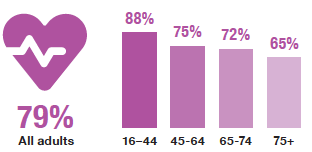
Women were more likely than men to report providing regular unpaid care.

Almost half of all adults reported living with a long-term condition, with prevalence increasing with age.
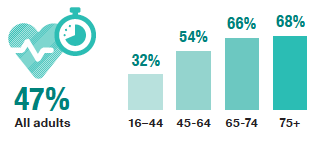
Higher proportions of men than women reported having / ever having:
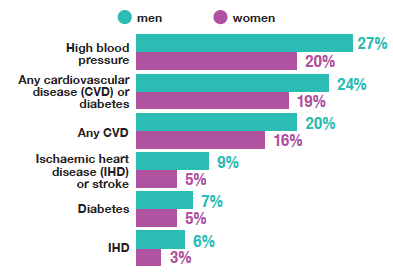
Prevalence of chronic obstructive pulmonary disease (COPD), chronic bronchitis or emphysema and doctor-diagnosed asthma varied by age but with differing patterns.
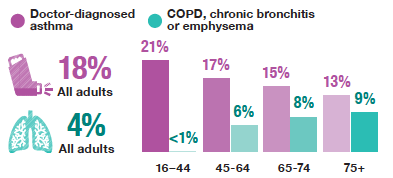
Among adults with doctor-diagnosed asthma, treatment was received* from:
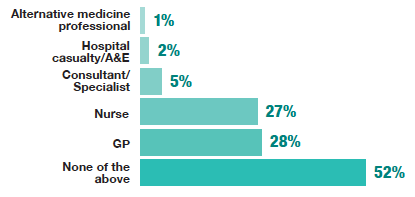
Higher proportions of adults who received a shielding letter or text reported having / ever having:
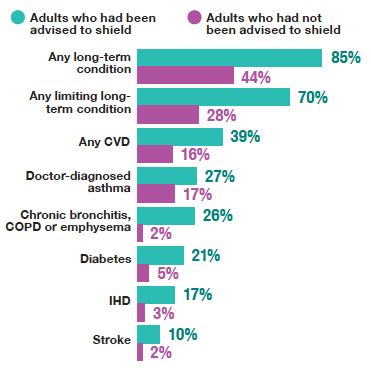
* In the last twelve months.
1 General Health, Long-Term Conditions and Caring
Line Knudsen
1.1 Introduction
Population measures of self-reported health are evidenced to be good predictors of mortality, morbidity or use of health care[1], reflecting subjective experiences of both diagnosed and undiagnosed illnesses (physical and mental) which can be overlooked by more objective measurements.
The prevalence of long-term conditions places considerable and unsustainable strain on healthcare provision[2], with further challenges presented by ongoing inequalities in health outcomes and an ageing population[3,4].
Providing unpaid care for a relative or friend is a role that can have a negative impact on physical and mental health and wellbeing[5]. In particular, during the pandemic, many carers have faced additional pressures while some services have been closed or operating at reduced capacity. Others have been providing care for the first time, to help family and friends limit their risk of infection.
The Scottish Government’s strategic policies focus on promoting and improving general health and wellbeing, as well as supporting those living with long-term illnesses/conditions and those who provide unpaid care. The six Public Health Priorities for Scotland[6] are aimed at improving the health of Scotland and are supported by a number of specific strategies covering long-term conditions overall[7], specific conditions such as heart disease[8], stroke[9] and diabetes[10] and embedding the rights of carers under The Carers (Scotland) Act 2016[11].
Around 180,000 people considered at the highest clinical risk from COVID-19 received a letter towards the start of the pandemic[12] advising them to stay at home and avoid face-to-face contact with those outside their household (shielding)[13].
Shielding was paused on the 31st July 2020 and at the time of data collection for this survey, easing of restrictions related to time outside of the home, social interactions and businesses that could open had been introduced including those previously advised to shield being told they no longer had to[14].
This chapter presents findings on self-assessed general health, the prevalence of long-term conditions (including cardiovascular disease, diabetes and respiratory conditions) and caring prevalence. Due to survey length, not all of the usual questions on long-term conditions were included, therefore some measures presented in this report were calculated differently to previous SHeS reports. Information on methods and definitions can be found in the Volume 2: Technical Report.
1.2 General Health, Long-Term Conditions & Caring
The fieldwork period referenced in the following analysis covers from the 5th August 2020 to the 23rd September 2020.
As prevalence of ‘good’ or ‘very good’ self-assessed health tends to be lower in deprived areas where response to this survey was lower than usual, the results in section 1.2.1 below may overestimate true prevalence. Conversely, prevalence of long-term conditions tends to be higher in deprived areas and hence the results in sections 1.2.2 to 1.2.6 below may underestimate true prevalence. In interpreting these results, also note section 1.9.2 of the technical report.
1.2.1 Adult self-assessed general health, August/September 2020, by age and sex
During fieldwork, around eight in ten (79%) adults described their health as ‘good’ or ‘very good’, while just 5% described their health as ‘bad’ or ‘very bad’. There were no significant variations by sex in the proportions that assessed their health to be either ‘good’ or ‘very good’ (78% among men and 80% among women).
Younger age groups were more likely to describe their health as ‘good’ or ‘very good’, with the proportion who did so decreasing from 88% among those aged 16-44 to 65% among those aged 75 and over. Similar patterns were found for men and women.
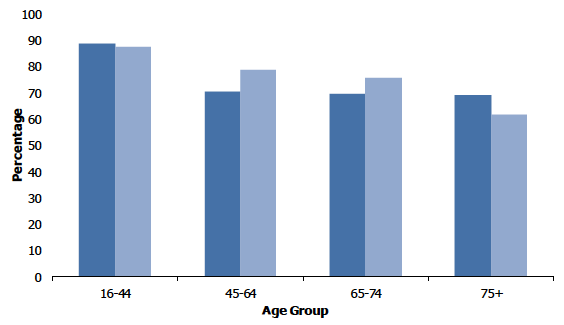
Figure 1A, Table 1.1
1.2.2 Prevalence of long-term conditions, August/September 2020, by age and sex
Just under half of adults (47%) reported that they were living with a long-term health condition, with 31% reporting that they lived with a limiting long-term condition, with no significant variations by sex.
The prevalence of any long-term condition (limiting and/or non-limiting) increased with age, from 32% among those aged 16-44 to 68% among those aged 75 and over. This pattern by age was similar among men and women. Table 1.2
1.2.3 Prevalence of cardiovascular disease (CVD), diabetes and high blood pressure, August/September 2020, by age and sex
Around one in five adults (18%) reported having any CVD during the fieldwork period, with prevalence higher among men (20%) than among women (16%). The prevalence of any CVD increased with age from 7% of all adults aged 16-44 to 45% among those aged 75 and over. Similar patterns by age were evident for both men and women.
Diabetes was reported by 6% of adults, with prevalence slightly higher among men (7%) compared with women (5%). There were also variations by age, with those aged 16-44 less likely than those in older age groups to have diabetes (2% compared with 9% - 12% among those aged 45 and over).
Among all adults, just over one in five (22%) reported that they had either any CVD or diabetes, with a higher prevalence recorded among men (24%) than among women (19%). Prevalence increased with age from 9% among those aged 16-44 to 50% among those aged 75 and over. Overall similar patterns by age were found for men and women although a sharper increase in prevalence between the 45-64 age group and the 65-74 age group was evident for men (16 percentage point increase for men compared to a two percentage point increase for women).
The prevalence of ischaemic heart disease (IHD) among all adults during the fieldwork period was 5%, with a significant increase by age from 0% of those aged 16-44 to 20% of those aged 75 and over. The pattern by age differed for men and women with a stepped increase for men from 0% among those aged 16-44 to 21% among those aged 75 and over whereas for women prevalence remained between 0% and 5% for those aged 16-74 before a sharp increase in prevalence between the 65-74 age group (5%) and the 75 and over age group (19%).
Just 3% of adults reported that they had ever had a stroke, with no significant difference by sex. Prevalence increased with age from 0% among those aged 16-44 to 13% among those aged 75 and over with a similar pattern found for men and women.
Prevalence of ever having either IHD or a stroke was 7% among all adults with higher prevalence among men (9%) than women (5%). This increased with age for both men and women, with significantly higher prevalence recorded among men aged 45-64 (12%) and 65-74 (19%) than women in the same age groups (4% and 8% respectively).
During the fieldwork period, more than a fifth of all adults interviewed reported ever having high blood pressure (23%), with a significant increase with age from 5% of those aged 16-44 to 52% of those aged 75 and over. Prevalence was higher among men (27%) than among women (20%). The pattern of high blood pressure prevalence by age differed for men and women. For women, prevalence increased gradually from 5% among women aged 16-44 to 55% among women aged 75 and over, whereas for men there was no clear pattern with an increase from 5% among those aged 16-44 to between 40% and 55% among those aged 45 and over.
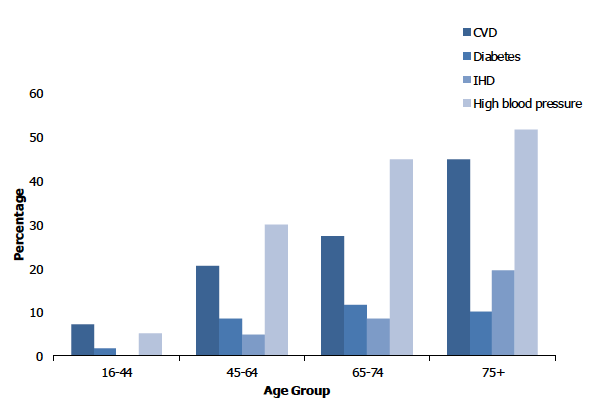
Figure 1B, Table 1.3
1.2.4 Prevalence of asthma and chronic obstructive pulmonary disease (COPD), chronic bronchitis or emphysema, August/September 2020, by age and sex
During the fieldwork period, 4% of adults reported ever having COPD, chronic bronchitis or emphysema and 18% reported doctor-diagnosed asthma. Both conditions were significantly associated with age but with differing patterns. The prevalence of COPD, chronic bronchitis or emphysema increased with age from <1% among those aged 16-44 to 6% - 9% among those aged 45 and over, while doctor-diagnosed asthma prevalence decreased with age from 21% among those aged 16-44 to 13% – 15% among those aged 65 and over. The pattern by age for doctor-diagnosed asthma was similar for men and women and differed only very slightly for COPD with a gradual increase by age for women but a less clear pattern for men. Table 1.4
1.2.5 Asthma treatment, August/September 2020, by age and sex
During the fieldwork period, around three in ten adults with doctor-diagnosed asthma reported having received treatment from their GP (28%) and/or from a nurse (27%) in the last twelve months. Less than one in ten adults with an asthma diagnosis had seen a consultant or specialist (5%), visited A&E (2%) and/or used alternative medicine (1%).
Over half of adults diagnosed with asthma (52%) had not received treatment from any of the above sources in the last twelve months. Younger adults and men were more likely not to have received treatment from any of the above sources during this period (63% among those aged 16-44 compared with 40% - 41% among those aged 45 and over and 60% of men compared with 44% of women). Table 1.5
1.2.6 Prevalence of long-term conditions, cardiovascular disease (CVD) and respiratory conditions, August/September 2020, by whether received shielding letter/text and sex
Of those who received a shielding letter or text, the vast majority (85%) had one or more long-term health conditions, with 70% reporting limiting long-term conditions compared with 44% and 28% respectively of those who had not received a shielding letter or text.
The largest variations in prevalence of long-term conditions between those advised to shield and those who were not were reported for COPD, chronic bronchitis or emphysema (29% and 2% respectively) and any CVD (39% and 16% respectively). These were followed by diabetes (21% among those advised to shield compared to 5% among those not advised to shield) and IHD (17% among those advised to shield compared to 3% among those not advised to shield). Smaller but still significant variations were also recorded for doctor-diagnosed asthma (27% and 17% respectively) and stroke (10% and 2% respectively).
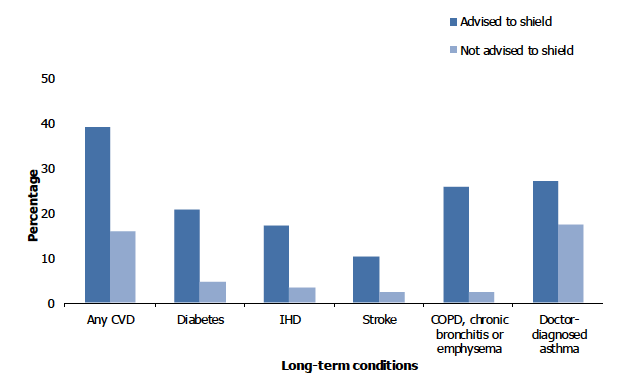
Figure 1C, Table 1.6
1.2.7 Caring prevalence, August/September 2020, by age and sex
During the fieldwork period, almost one in five (19%) adults reported that they provided regular unpaid care, with women more likely to do so than men (23% and 14% respectively). Caring prevalence also varied by age, increasing from 12% of those aged 16-44 to 28% of those aged 45-64, before decreasing to 14% - 18% among those aged 65 and over. A similar pattern was found for women, however, for men there was no clear pattern by age.
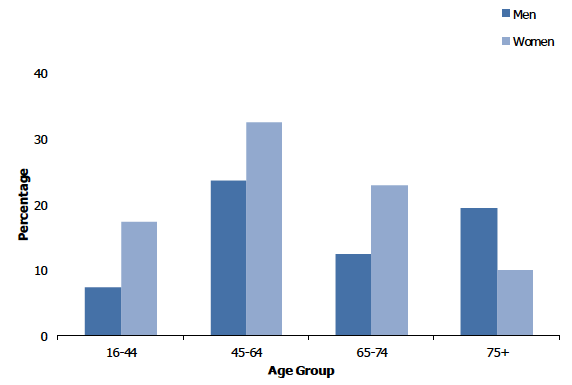
Figure 1D, Table 1.7
Table List
Table 1.1 Adult self-assessed general health, August/September 2020, by age and sex
Table 1.2 Prevalence of long-term conditions, August/September 2020, by age and sex
Table 1.3 Prevalence of cardiovascular disease (CVD), diabetes and high blood pressure, August/September 2020, by age and sex
Table 1.4 Prevalence of asthma and chronic obstructive pulmonary disease (COPD), chronic bronchitis or emphysema, August/September 2020, by age and sex
Table 1.5 Asthma treatment, August/September 2020, by age and sex
Table 1.6 Prevalence of long-term conditions, cardiovascular disease (CVD) and respiratory conditions, August/September 2020, by whether received shielding letter/text and sex
Table 1.7 Caring prevalence, August/September 2020, by age and sex
The tables can be found in the main report page under supporting documents.
References and notes
1. Vaillant, N and Wolff, FC (2012). On the reliability of self-reported health: Evidence from Albanian Data. Journal of Epidemiology and Global Health; 2(2): 83-98.
2. The Scottish Government (2018). Public Health Priorities for Scotland. [Online]
3. COSLA and the Scottish Government (2020). The reform programme: why reform is important. [Online]
4. ScotPHO. (2019). Older people: key points. [Online]
5. Scotland's Carers (2015), Edinburgh, Scottish Government, 2015.
6. Public Health Priorities for Scotland, Edinburgh: Scottish Government/COSLA, 2018.
7. Improving the Health and Wellbeing of People with Long Term Conditions in Scotland: A National Action Plan (2009). Edinburgh: Scottish Government.
8. Heart Disease Improvement Plan (2014). Edinburgh: Scottish Government, 2014.
9. Stroke Improvement Plan (2014). Edinburgh: Scottish Government, 2014.
10. Diabetes Improvement Plan (2014). Edinburgh: Scottish Government, 2014.
11. Carers (Scotland) Act 2016: Implementation Plan 2018-2020, Edinburgh, Scottish Government, 2017.
12. Shielding to be paused, Edinburgh, Scottish Government, 2020.
13. Directorate for Chief Medical Office. Shielding guidance for high risk vulnerable patients. Edinburgh, Scottish Government, 2020.
14. Coronavirus (COVID-19): Scotland’s route map. Edinburgh: Scottish Government (2020).
Contact
There is a problem
Thanks for your feedback